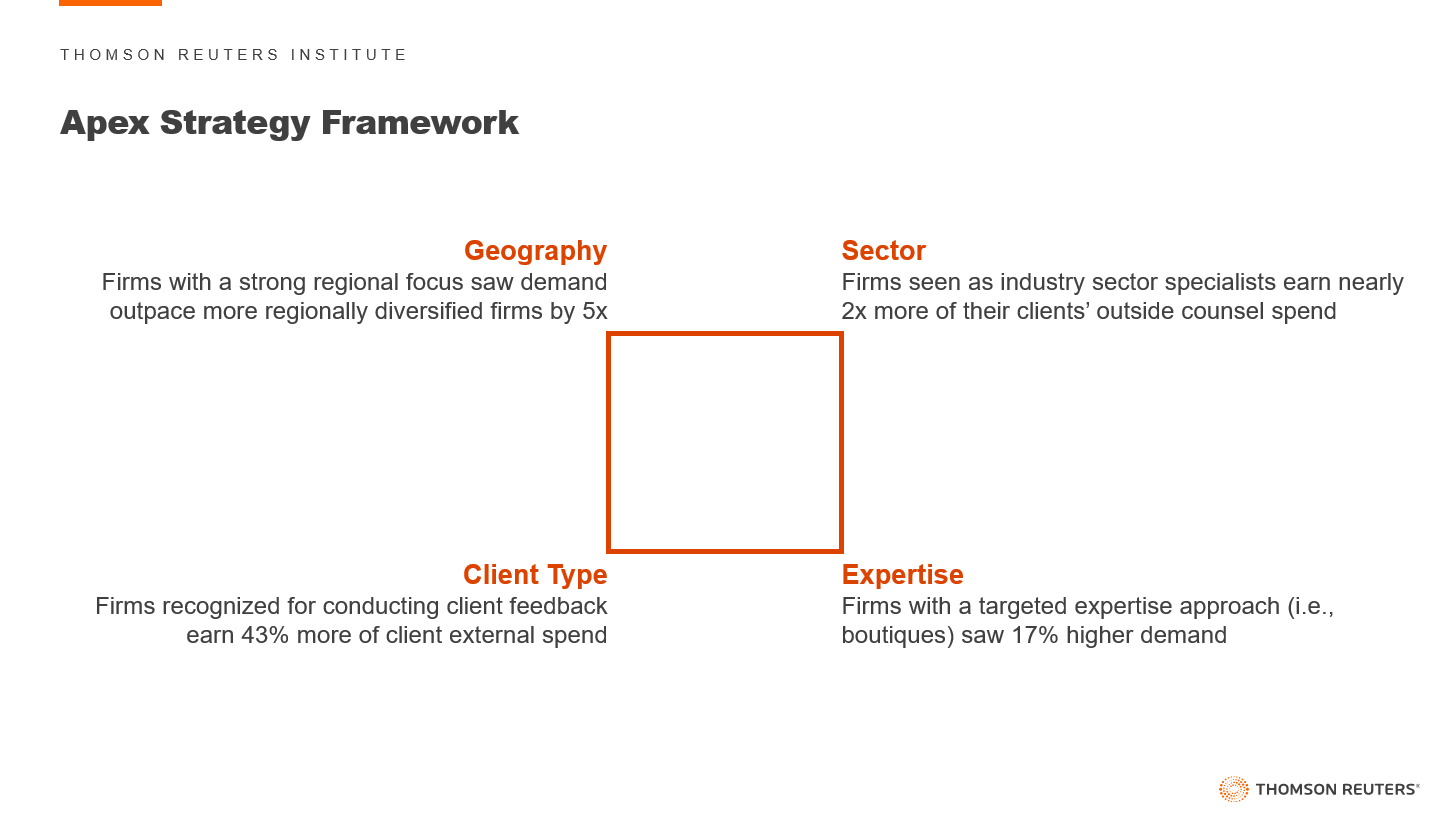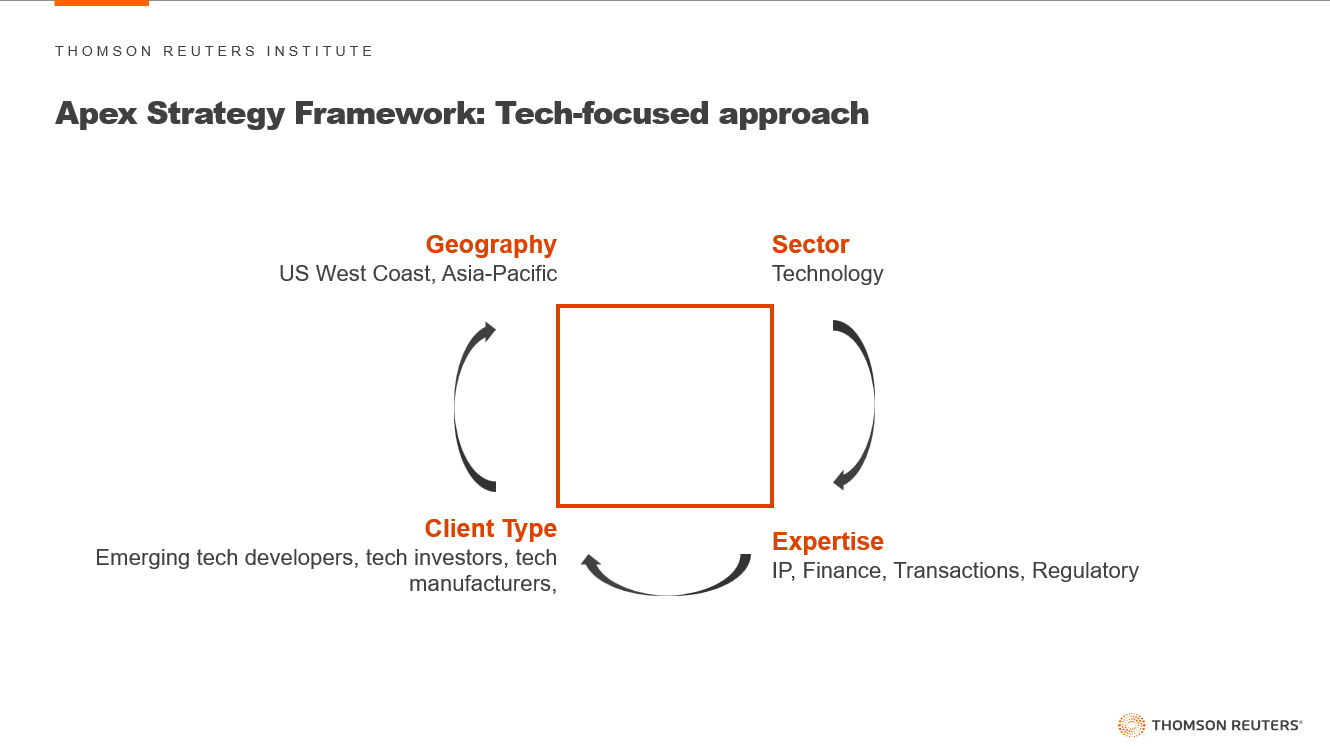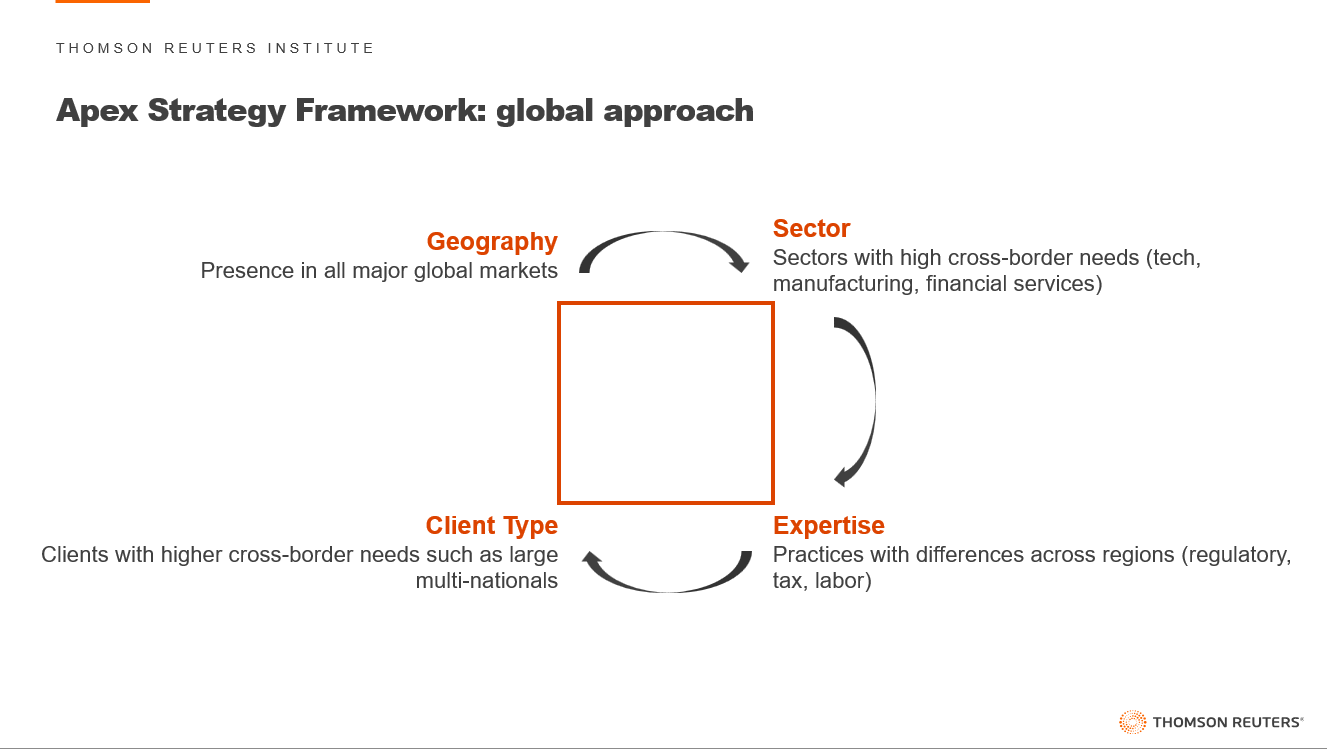By using the Apex Strategy Framework, law firms can develop methods to foster higher levels of collaboration among attorneys, resulting in more robust business growth
Most law firms recognize the importance of a focused approach to growth yet struggle with developing a cohesive strategy to which every person at the firm can commit. Often, this means growth is largely organic and circumstantial rather than an intentional effort.
As legal clients’ spend optimism begins to slow from record highs, law firms are looking to carve out more targeted — and intentional — growth strategies. Specifically, strategies that will deliver growth that outpaces the industry average.
In this article, we merge our Thomson Reuters Institute’s research with legal clients and our law firm financial data to examine the success of firms that put a unified strategy to good effect and see the tangible benefits which can result. This research presented draws on data from two key sources: our Market Insights research, an ongoing, annual study conducted with more than 2,100 general counsel and senior corporate law department decision makers; and our Financial Insights data, a benchmarking tool that analyzes financial and operational data of more than 240 law firms.
What drives outsized growth?
There are many factors that contribute to law firm performance in a given year. Quality of work, brand differentiation, pricing strategies, expense management — the list is endless. Far fewer factors can be linked to the most important long-term factors of success: increasing a firm’s share of client spend and demand (seen as an increase in billable hours).
Our research shows one of the most influential ways to drive growth is to take a more focused approach to the market. The numbers are compelling. In short, law firms that prioritize one market approach over multiple approaches, on average, experience higher demand or share of client external spend than other firms.
Into this, we introduce the Apex Strategy Framework, which is simple in theory. A firm makes one corner of the framework its primary focus and uses that focus to drive decisions and investments as it travels around the square.

Naturally, firm performance is dependent on more than growth. For example, making sure expenses aren’t outpacing growth on an ongoing basis is critical. That said, it is typically easier for firms to control expenses than it is to find a recurring source of new dollars in the market.
Avoid the trap of diluting focus
The below example uses a hypothetical law firm that might want to make its focus the Technology sector. Using the Apex Strategy Framework, this firm will look at the market through the lens of the Technology sector when it comes to hiring, selecting new office locations, and pursuing new work and clients.

The beauty of the model is a firm can make any corner its apex focus. Even a large, global law firm with a diversified portfolio of practices can use this strategy. This approach helps communicate to the firm’s lawyers — who then communicate to clients — what the firm’s point of differentiation is within the market.

The challenge most firms face is limiting themselves to a singular focus. The unintentional error we see most frequently is one in which firms create a strategy that sends conflicting messages out into the market. For instance, these conflicting messages might include touting a global presence, but also strongly pursuing domestic, high-stakes work; or deciding on an industry-focused go-to market approach in more than three unrelated industries.
A structure to promote better collaboration
In addition to sending a consistent cohesive message to clients (and prospects) as to what makes a firm different than others, the Apex Strategy Framework provides a formal structure around which lawyers can collaborate.
Indeed, collaboration is the golden goose for law firms. Our research shows that those law firms seen by clients as having effective collaborative teams earn, on average, more than half of their clients’ external legal spend. We also see that those lawyers who are high collaborators, on average, see nearly three-times the originations of lawyers who are lone operators, and those same super-collaborators bill 17% more hours a year than less collaborative lawyers.
Despite the financial impact of collaboration, law firms have struggled to create an environment where intentional, business-generative collaboration is the norm. And this is where the Apex Strategy Framework offers additional help. Firms with a distinct focus on how they approach the market tend to work together more easily. Looking at different apex strategies, we can see the tools firms use to bring their firm’s offerings to clients in a cohesive manner. Grouped by strategies, these offerings include:
-
-
- By client type — These firms tend to use key account management (also called client teams) to build a holistic suite of offerings to their target client types. At the heart of their messaging is, “No other firm will understand your business and goals better than we do.”
- By industry sectors — These firms use industry teams in which lawyers across multiple disciplines can approach clients and prospects with a clear message about helping navigate clients through the unique demands of a particular industry sector.
- By geography — Whether a hyper-regionally focused firm (“We bring together our lawyers across work-types to handle all your Midwest needs”) or a firm with large-scale global pursuits (“No other firm can navigate more jurisdictions for your global business”), a message that lets clients know exactly in what areas a firm can help them is a magnet for work in those regions.
- By expertise — Even for law firms with a single or focused offering of expertise, the ability to collaborate across sub-practices is critical to become a one-stop shop for every need that clients might have in this specific area.
-
Conclusion
Success stories are not built overnight. The best written narratives are about those who come from an underdog position to take the king’s reward, and this is known to take time. Working individually might be an organization’s culture, but team leadership can structure future success for all those around them.
Of course, that means using evidence to help choose messaging carefully and establish a firm’s apex strategy, attracting both the clients and the talent that firm leadership wants in order to ensure productive relationships.
To find deeper insight into an Apex Strategy or the wider research that underpins this article, click here.







